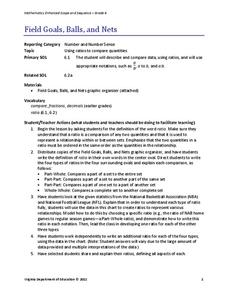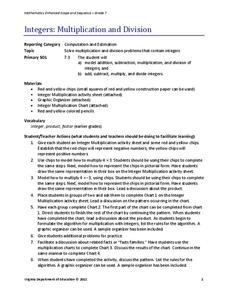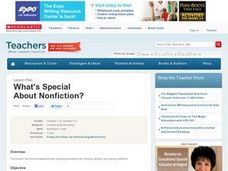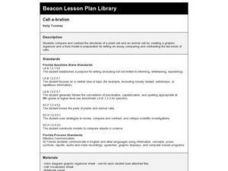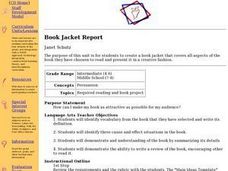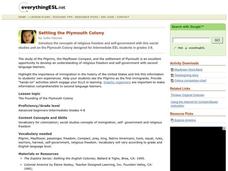Virginia Department of Education
Field Goals, Balls, and Nets
Score a resource on ratios. Young mathematicians learn about different ways to express ratios. Using sports data, they write statements about the statistics in ratio form.
Virginia Department of Education
Integers: Multiplication and Division
Rules are meant to be broken ... but not integer multiplication and division rules. Learners use chips to model integer multiplication and division. The results of the activity help them develop integer rules for these operations.
Curated OER
Picture Dictionary
Students write and contribute one page for a class picture dictionary. They discuss how to alphabetize words, and examine both regular and picture dictionaries and how they are organized. Next they create a page for the class dictionary...
Curated OER
Military Families
Tenth graders recognize and define vocabulary words. In this Military families instructional activity, 10th graders participate in a shoot n spell game. Students write the vocabulary in sentences, read words in text, and...
Curated OER
What's Special About Nonfiction?
Young scholars examine the difference between nonfiction and fictional writing. They identify the characteristics of nonfiction literature and examine how a nonfiction textbook organizes information.
Historical Thinking Matters
Spanish-American War: 3 Day Lesson
Why did the United States choose to invade Cuba in 1898? As part of a 3-day lesson, your young historians will first develop working hypotheses to answer this question, then work with a variety of historical primary source documents that...
Curated OER
"Rikki-tikki-tavi"
“Rikki-tikki-tavi” provides an opportunity to model for readers how to use background information to enrich understanding of a story. Class members observe animal behavior, listen to biographical background on Rudyard Kipling, study...
Curated OER
Analyzing Story Structure
Pupils explore language arts by completing a graphic organizer in class. For this story structure lesson, students read the poem "Sick" by Shel Silverstein and discuss the different elements in the piece which make it an effective...
Curated OER
Cell-a-bration
Fifth graders study the structures of a plant cell and animal cell. They create a graphic organizer and a food model. Finally, they write an essay comparing and contrasting plant and animal cells.
Curated OER
Algebraic Processes And Its Connection To Geometry
Students investigate the concept of polygons using a variety of activities. They explore the vocabulary of polygons by constructing a graphic organizer. Then students categorize the characteristics of several polygons and contribute the...
Virginia Department of Education
Functions 2
Demonstrate linear and quadratic functions through contextual modeling. Young mathematicians explore both types of functions by analyzing their key features. They then relate these key features to the contextual relationship the function...
Cornell University
The Making of Macromolecules
Compare and contrast macromolecules made from the same elements. Young scholars learn how the structure of a molecule has as much influence on a compound as the elements in the molecule. They experiment with molecular model kits to...
Curated OER
Guided Reading: " A River Ran Wild"
Students answer "essential questions" to establish background and prior knowledge of the book, "A River Ran Wild." In this language arts lesson, 3rd graders complete a graphic organizer of vocabulary words and read and take notes at...
Curated OER
Vocab Grabbing the Preamble to the U.S. Constitution
Students identify concrete and abstract nouns in the preamble to the Constitution, and complete Frayer Model graphic organizers using history and current events as examples of American values. In this preamble lesson plan, students use...
Classroom Adventures Program
Creating Characters
Examine character in depth. Over the course of these six lessons, learners explore their own character traits, determine the traits of characters in the books they read, practice comparing and contrasting, and collaborate in small...
Curated OER
Glossary, Index, and Table of Contents
Fourth graders use two separate sources to learn about index, glossary, and table of contents usage. In this library lesson, 4th graders use two books, Learning About Weather with Graphic Organizers, and The World Almanac for Kids, to...
Virginia Department of Education
Quadratic Equations
Review the multiple methods of solving quadratic equations through an analysis of the discriminant. Scholars use the discriminant to determine the best solution method and then solve various equations. As a challenge, learners build...
Curated OER
Book Jacket Report
Students create a book jacket that covers a book they have chosen to read. They present their jacket to the class in a creative fashion. Students outline the main ideas of each chapter. They design their book jackets and complete a...
Curated OER
Great Depression and the New Deal
Students create a timeline detailing the events of the Great Depression to identify causes of the Great Depression. Then students organize the programs created by the New Deal using a graphic organizer.
Curated OER
Settling the Plymouth Colony
Students use the Internet and graphic organizers to research the Plymouth Colony the experience of the Pilgrims. Students compare and contrast different colonies and develop a timeline showcasing their research.
Serendip
Evolution and Adaptations
Survival of the fittest isn't just for the movies! A five-part lesson plan explores several different species with known adaptations and analyzes them for their survival strategies. Using both video and research data, scholars draw...
School Improvement in Maryland
Monetary Policy
As an introduction to monetary policy, groups investigate and evaluate the effectiveness of current monetary and fiscal policies on promoting full employment, price stability, and economic performance. They then apply monetary tools...
Teach Engineering
Cell Membrane Structure and Function
Teach your class how to get out of a cell — or break in. The third installment in a seven-part series introduces the class to cell membranes and their functions. The lesson plan includes information to present to the class,...
Cornell University
Plant Cell Crime Scene
Use science to solve the mystery of the Poplar murder. Pupils use forensic botany to determine if a suspect could be the killer. By analyzing images from a Transmission Electron Microscope, learners determine if the material found on the...
